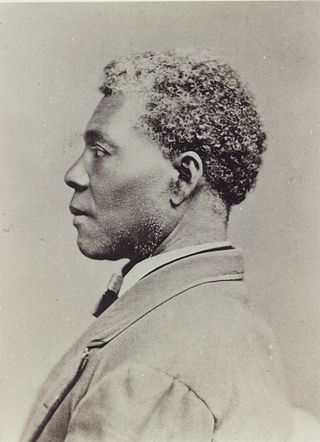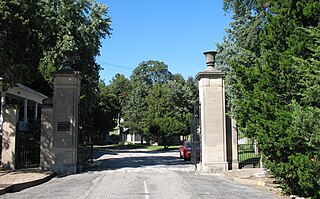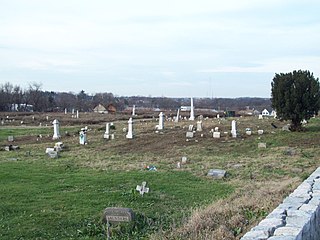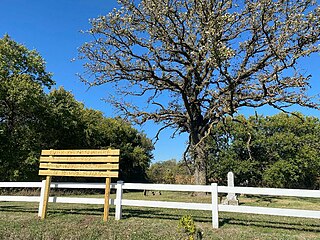
Kirkwood is an inner-ring western suburb of St. Louis located in St. Louis County, Missouri. As of the 2010 census, the city's population was 27,540. Founded in 1853, the city is named after James P. Kirkwood, builder of the Pacific Railroad through that city. It was the first planned suburb located west of the Mississippi River.

Saint Louis Cemetery is the name of three Catholic cemeteries in New Orleans, Louisiana. Most of the graves are above-ground vaults constructed in the 18th and 19th centuries.

The Missouri Botanical Garden is a botanical garden located at 4344 Shaw Boulevard in St. Louis, Missouri. It is also known informally as Shaw's Garden for founder and philanthropist Henry Shaw. Its herbarium, with more than 6.6 million specimens, is the second largest in North America, behind that of the New York Botanical Garden. The Index Herbariorum code assigned to the herbarium is MO and it is used when citing housed specimens.

Bellefontaine Cemetery is a nonprofit, non-denominational cemetery and arboretum in St. Louis, Missouri. Founded in 1849 as a rural cemetery, Bellefontaine is home to a number of architecturally significant monuments and mausoleums such as the Louis Sullivan-designed Wainwright Tomb, which is listed on the National Register of Historic Places.

Archer Alexander was a formerly enslaved American man who served as the model for the "emancipated slave" in the Emancipation Memorial 1876 located in Lincoln Park in Washington, D.C. He was the subject of an 1885 biography, The Story of Archer Alexander, from Slavery to Freedom, March 30, 1863 by William Greenleaf Eliot, published in 1885. Eliot's account of Alexander's life is partly historical fiction, as portions of the narrative were altered by his close friend Jesse Benton Fremont at the request of the publishers.

Mount Mora Cemetery is the oldest public cemetery in St. Joseph, Missouri. Among those who are buried in the cemetery are three governors, a U.S. senator, soldiers from both sides in the American Civil War and riders of the Pony Express. In October 2006, several headstones including that of Missouri governor Silas Woodson were damaged by vandals.

The Old Lorimier Cemetery in Cape Girardeau, Missouri was established between 1806 and 1808 by Louis Lorimier. The cemetery is located at 500 North Fountain Street overlooking the Mississippi River. There are believed to be more than 6,500 graves in the cemetery, most of them unmarked. A sidewalk serves as a north – south dividing line in the cemetery. It is said that Catholics are buried on the south and Protestants are buried on the north. The east slope is believed to be the burial grounds of African-American persons. It has been recorded that as many as 1,200 soldiers from the Civil War were buried there. The grave marker for the wife of Louis Lorimier says "The Noblest Matron of the Shawnee race."
Quinette Cemetery is a historic landmark and African-American burial ground located in Kirkwood, Missouri, a suburb of the city of St. Louis.

Mount Auburn Cemetery is a historic African American cemetery and national historic district in Baltimore, Maryland, United States. Overlooking the Middle Branch of the Patapsco River to the east, Baltimore's Downtown to the north and railroad tracks to the south, Mt. Auburn Cemetery is surrounded by the Cherry Hill, Westport, Mt. Winans and Lakeland communities.

Sugarloaf Mound is the sole remaining Mississippian culture platform mound in St. Louis, Missouri, a city commonly referred to in its earlier years as "Mound City" for its approximately 40 Native American earthen structures.

Harriet Tubman Grave is an historic gravesite located in Fort Hill Cemetery at Auburn, in Cayuga County, New York. The granite gravestone marks the resting place of famed African-American abolitionist and Christian Harriet Tubman, who was born into slavery in Maryland in the United States in 1822.

Mount Zion African Methodist Episcopal Church and Mount Zion Cemetery is a historic church and cemetery located at 172 Garwin Road in Woolwich Township, New Jersey, United States. The church was a stop on the Greenwich Line of the Underground Railroad through South Jersey operated by Harriet Tubman for 10 years. The church provided supplies and shelter to runaway slaves on their way to Canada from the South. The church and cemetery were part of the early 19th-century free negro settlement sponsored by Quakers known as Small Gloucester.

John Berry Meachum (1789–1854) was an American pastor, businessman, educator and founder of the First African Baptist Church in St. Louis, the oldest black church west of the Mississippi River. At a time when it was illegal in the city to teach people of color to read and write, Meachum operated a school in the church's basement. Meachum also circumvented a Missouri state law banning education for black people by creating the Floating Freedom School on a steamboat on the Mississippi River.

Moses Dickson (1824–1901) was an abolitionist, soldier, minister, and founder of the Knights of Liberty, an anti-slavery organization that planned a slave uprising in the United States and helped African-American enslaved people to freedom through the Underground Railroad. He also founded the black self-help organization The International Order of Twelve Knights and Daughters of Tabor and was a co-founder of Lincoln University in Missouri.

The Glendale Memorial Park Cemetery is a historic cemetery located at 7844 North 61st Avenue in Glendale, Arizona. The cemetery was originally called Glendale Memorial Park. It is the final resting place of various notable early citizens of Glendale. Among those who are interred in the cemetery are early pioneers, mayors, businessman and veterans who fought in every military conflict in which the United States has been involved starting from the American Civil War onward. Also, in the cemetery there is a memorial and 16 graves of immigrant farmers who perished in 1959, in a bus accident on Central Avenue.
Washington Park Cemetery is a historic African-American cemetery active from 1920 until 1980 and located in Berkeley, Missouri, a suburb of St. Louis, Missouri. Large-scale disinterment occurred over several decades for various construction projects. As of 2022, local cleanup efforts continue due to its long-term state of disrepair.

South Jordan Cemetery, also known as the Black Cemetery or the Negro Cemetery, is a historic site located north of Moorhead in rural Monona County, Iowa, United States. It was listed on the National Register of Historic Places in 2021.

Father Dickson Cemetery is a historic African-American cemetery located on 845 South Sappington Road in Crestwood, St. Louis County, Missouri.



















